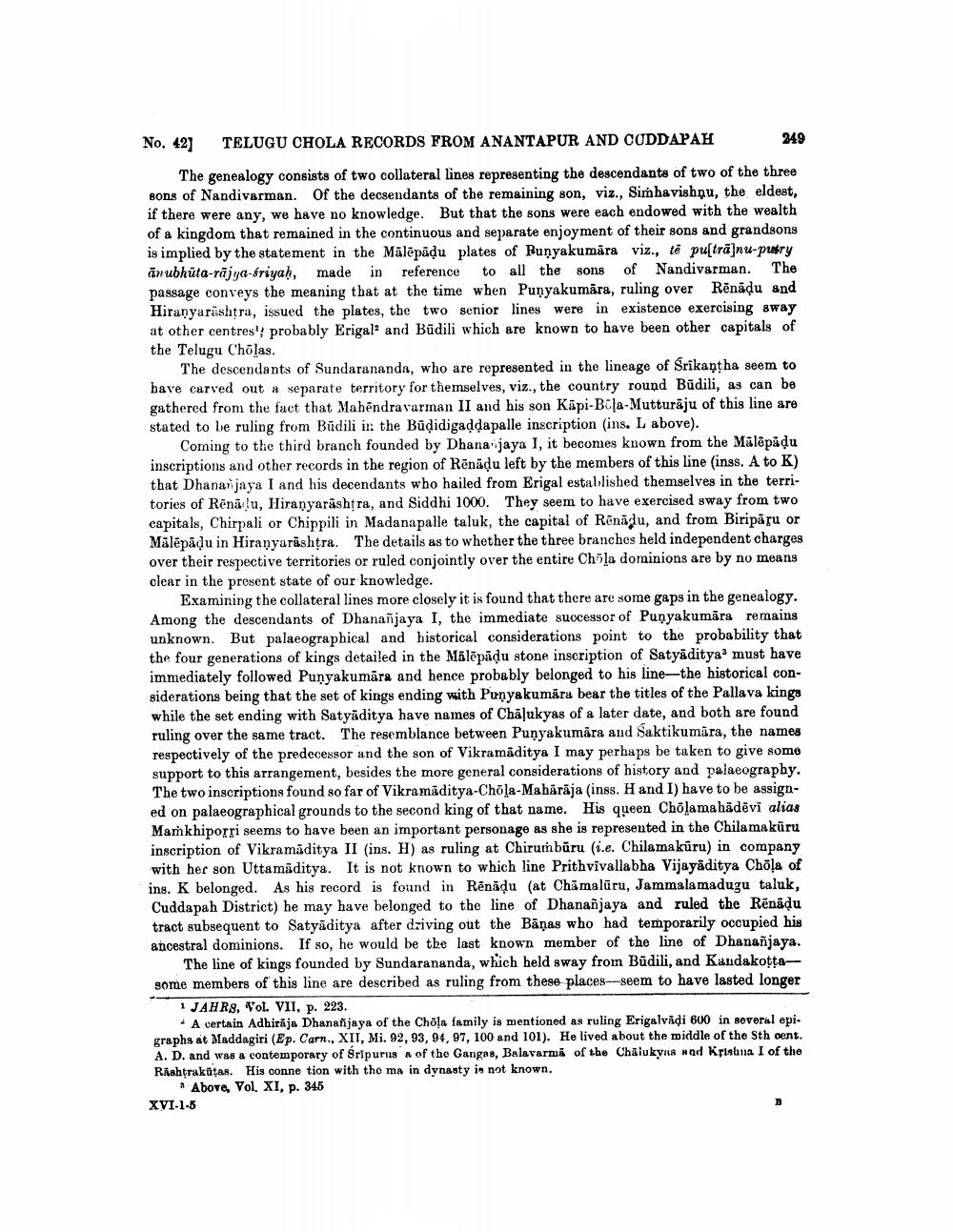________________
249
No. 42]
TELUGU CHOLA RECORDS FROM ANANTAPUR AND CUDDAPAH
The genealogy consists of two collateral lines representing the descendants of two of the three sons of Nandivarman. Of the decsendants of the remaining son, viz., Simhavishnu, the eldest, if there were any, we have no knowledge. But that the sons were each endowed with the wealth of a kingdom that remained in the continuous and separate enjoyment of their sons and grandsons is implied by the statement in the Mālēpāḍu plates of Bunyakumara viz., të pu[tra]nu-pusry anubhūta-rajya-sriyaḥ, made in reference to all the sons of Nandivarman. The passage conveys the meaning that at the time when Punyakumara, ruling over Renaḍu and Hiranyarashtra, issued the plates, the two senior lines were in existence exercising sway at other centres1; probably Erigal and Budili which are known to have been other capitals of the Telugu Chōlas.
The descendants of Sundarananda, who are represented in the lineage of Srikantha seem to have carved out a separate territory for themselves, viz., the country round Budili, as can be gathered from the fact that Mahendravarman II and his son Kapi-Bila-Mutturaju of this line are stated to be ruling from Budili in the Būḍidigaḍdapalle inscription (ins. L above).
Coming to the third branch founded by Dhananjaya I, it becomes known from the Mālēpāḍu inscriptions and other records in the region of Renäḍu left by the members of this line (inss. A to K) that Dhananjaya I and his decendants who hailed from Erigal established themselves in the territories of Renau, Hiranyarashtra, and Siddhi 1000. They seem to have exercised sway from two capitals, Chirpali or Chippili in Madanapalle taluk, the capital of Renadu, and from Biriparu or Mālēpādu in Hiranyarashtra. The details as to whether the three branches held independent charges over their respective territories or ruled conjointly over the entire Chola dominions are by no means clear in the present state of our knowledge.
Examining the collateral lines more closely it is found that there are some gaps in the genealogy. Among the descendants of Dhananjaya I, the immediate successor of Punyakumara remains unknown. But palaeographical and historical considerations point to the probability that the four generations of kings detailed in the Malēpādu stone inscription of Satyaditya3 must have immediately followed Punyakumara and hence probably belonged to his line-the historical considerations being that the set of kings ending with Punyakumara bear the titles of the Pallava kings while the set ending with Satyaditya have names of Chalukyas of a later date, and both are found ruling over the same tract. The resemblance between Punyakumara and Saktikumāra, the names respectively of the predecessor and the son of Vikramaditya I may perhaps be taken to give some support to this arrangement, besides the more general considerations of history and palaeography. The two inscriptions found so far of Vikramaditya-Chōla-Mahārāja (inss. H and I) have to be assigned on palaeographical grounds to the second king of that name. His queen Chōlamahādēvi alias Mamkhiporri seems to have been an important personage as she is represented in the Chilamakuru inscription of Vikramaditya II (ins. H) as ruling at Chirumbūru (i.e. Chilamakuru) in company with her son Uttamaditya. It is not known to which line Prithvivallabha Vijayaditya Chōla of ins. K belonged. As his record is found in Renaḍu (at Chamaluru, Jammalamadugu taluk, Cuddapah District) he may have belonged to the line of Dhananjaya and ruled the Renāḍu tract subsequent to Satyaditya after driving out the Bāņas who had temporarily occupied his ancestral dominions. If so, he would be the last known member of the line of Dhananjaya.
The line of kings founded by Sundarananda, which held sway from Budili, and Kandakoṭṭasome members of this line are described as ruling from these places-seem to have lasted longer
1 JAHRS, Vol. VII, p. 223.
A certain Adhiraja Dhanafijaya of the Chola family is mentioned as ruling Erigalvadi 600 in several epigraphs at Maddagiri (Ep. Carn., XII, Mi. 92, 93, 94, 97, 100 and 101). He lived about the middle of the Sth cent. A. D. and was a contemporary of Sripurus a of the Gangas, Balavarma of the Chalukyas nad Krishna I of the Rashtrakutas. His conne tion with the ma in dynasty is not known.
3 Above, Vol. XI, p. 345
XVI-1-5




